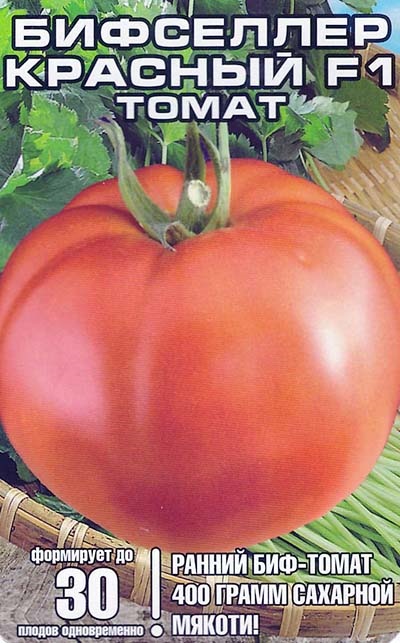
- Category: hybrid
- Growth type: indeterminate
- Appointment: fresh consumption, for pickling and preserving
- Ripening period: early
- Ripening time, days: 97-105
- Growing conditions: for closed ground
- Marketability: high
- Bush size: tall
- Bush height, cm: 150-170
- Ripe fruit color: red, no green spot at the stalk
An obligatory crop in every garden is tomato. Despite the fact that they are all good, beef tomatoes are especially fond of. These are large-fruited fleshy salad hybrid varieties. The difference in this category is that the fruits have increased sugar content and more vitamins. One of these hybrids is the indeterminate Bifseller red, intended for greenhouses. Not the largest of the beefs, but almost a record holder in yield. Tomato fruits have a great taste and are used to prepare summer and winter salads.
Breeding history
The authorship in the emergence of the line of hybrid indeterminate varieties Bifseller, including Bifseller red, belongs to the Novosibirsk agricultural firm "Siberian Garden". The company specializes in the production of fruits and vegetables for cultivation in areas of risky farming.
Description of the variety
A tall bush, whose height reaches 1.5-1.7 m, is covered with carved green foliage of medium size. It is prone to a large formation of stepsons and fattening, therefore, it needs the formation and control of nitrogen. The first ovary is laid above 6-8 leaves, all subsequent ones after 1-2 leaves. The number of fruits in one cluster is from five to seven pieces, the main stem is able to withstand up to seven clusters. The total number of tomatoes on one root reaches 50 pieces. The quantity can be even more, if you do not engage in shaping, but the fruits will be small, with low taste characteristics.
The main qualities of the fruit
Large flat-round fruits with a small spout, weighing 400 g, covered with a dense glossy skin. Unripe tomatoes are colored milky green, with the onset of technical ripeness, the fruits are colored carmine red without a green spot in the region of the stalk. Bifseller red is characterized by fasciation (intergrowth of flowers), due to this, an irregularly shaped fruit can form in the first ovary, which must be removed. The hybrid has high commercial qualities, is very decorative, but is characterized by poor transportability.
Taste characteristics
Hybrid tomatoes have a sweet dessert taste, they contain an increased amount of lycopene, a natural antioxidant that has a beneficial effect on cardiovascular activity, as well as a lot of β-carotene and lutein.
Ripening and fruiting
The indeterminate hybrid is characterized by early ripening periods - from 75 to 105 days.
Yield
Bifseller red is characterized by high yield - up to 50 large fruits from one bush, 18-22 kilograms are removed from one square meter.
The timing of planting seedlings and planting in the ground
The tomato of this hybridization is grown only through seedlings, the seeds are sown in April-May.

Growing tomato seedlings is an extremely important process, because it largely depends on whether the gardener can harvest at all. All aspects must be taken into account, from seedbed preparation to planting in the ground.
Landing scheme
The recommended planting pattern is no more than three plants per square meter.

Growing and care
Beef tomatoes require special agricultural technology, since the fruits are poured not only due to a large number of cells (the effect of nitrogen), but also due to an increase in their size (good watering). At the time of the onset of the sultry season, plants need potash foliar feeding on the leaf. The bush is formed into one stem, less often into two. Each leaf should receive a sufficient amount of sunlight, so gardeners have to deal not only with pinching and shaping, but also shortening the leaf plate.
If there is not enough light, then evening supplementary lighting is carried out, and not night lighting, otherwise it can provoke the appearance of weak plants. The optimal temperature inside the greenhouse is equally important, and this is a range of 16-20 degrees at night, when the nutrients accumulated during the day are supplied to the growth points. Daytime temperatures should be between 22-25ºC. Timely carbon dioxide fertilizing is necessary - compost (fermented nettles, bread, weeds), manure and others.




A plant needs different micronutrients at each stage of growth. All fertilizers can be divided into two groups: mineral and organic. Folk remedies are often used: iodine, yeast, bird droppings, eggshells.
It is important to observe the rate and period of feeding. This also applies to folk remedies and organic fertilizers.
Disease and pest resistance
Large-fruited hybrids do not differ in strong immunity, therefore late blight and alternaria are dangerous for them. It is recommended to carry out preventive treatments with "Ordan" approximately two decades before harvesting.


Resistant to adverse weather conditions
The hybrid is intended for growing indoors, so weather conditions do not affect it too much, the main thing is to comply with the necessary conditions of agricultural technology inside the greenhouse.
Growing regions
Bifseller red was bred by Novosibirsk breeders, therefore it was initially adapted for growing in greenhouses in cold regions - Eastern, Western, South-Western Siberia. In addition, it is grown in the middle lane, in the regions of the Black Earth Region and others.

























































































